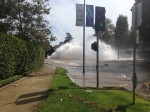The Los Angeles Department of Water and Power said it has not improved its infrastructure because it is still researching new technologies since a water main burst on Sunset Boulevard a year ago and flooded Bruin Plaza and UCLA parking lots.
The water main burst flooded 20 million gallons of water onto Bruin Walk and into Pauley Pavilion and Parking Structures 4 and 7. The main was built 94 years ago.
LADWP, which maintains the pipes in question, is researching early-warning leak systems, many of which use magnetic imaging to scan plumbing.
These systems, however, do not necessarily work well with the different varieties of underground pipes that have accumulated over the years as Los Angeles has expanded into a metropolis, said Julie Spacht, LADWP’s water executive managing engineer.
Madelyn Glickfeld, UCLA Water Resources Group director who recently co-authored a study on the efficiency of water distribution in Los Angeles County, said she thinks putting smart meters into the system that could monitor the input and output in specific areas is a simpler albeit a potentially more expensive solution.
As of now, LADWP has not decided on a newer system or systems to implement.
“We’re looking through all the available emerging technology,” Spacht said. “We have a lot of resources.”
LADWP not updating its infrastructure has caused it millions of dollars in claims and damages.
In the months following the burst, about 800 members of the UCLA community and visitors had to submit claims to insurance companies and LADWP.
In all, LADWP paid out about $2.5 million dollars in damages for the vehicles damaged in the flood, LADWP spokeswoman Ellen Cheng said in an email statement.
UCLA also recently submitted a claim demanding $13 million in compensation for damages sustained during the flood.
A year after the flood, LADWP is not done addressing compensation claims, said Cheng.
As LADWP is addressing those claims, some have asked LADWP to look into preventing similar incidents in the future.
Glickfeld said she thinks the flood at UCLA highlighted the importance of underground infrastructure.
Glickfeld added she thinks the city’s underground water supply infrastructure renders it more easily overlooked than other infrastructure.
“Because we’re in such desperate water circumstances, it’s important to save millions and millions of gallons by fixing leaks,” she said.
LADWP oversees the maintenance of the two pipes involved in last year’s flood and uses a ranking system to establish a priority basis for replacing old pipes.
Many factors are used to assess each pipe, including the impact pipes have on customers, Spacht said. Pipes that route water to hospitals, for example, are given priority. In certain cases, a highly populated university like UCLA might also be given priority, but wasn’t, she said.
Glickfield said because of the unusually expansive size of Los Angeles’s piping system, its age and a dearth of maintenance workers, LADWP faces a difficult task that can only be improved with updated leak monitoring systems.
“Until they have the technology, they only know about the leaks on the streets,” she said.
